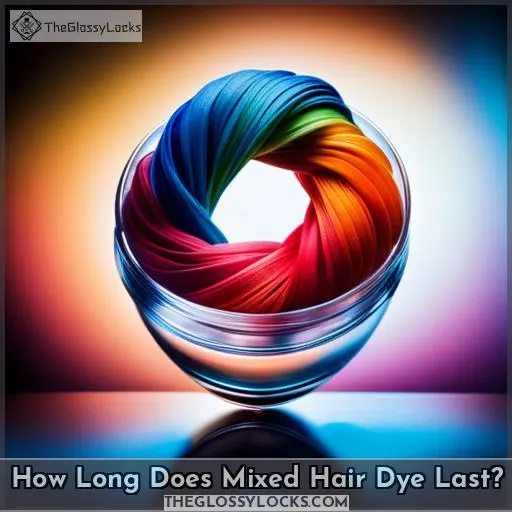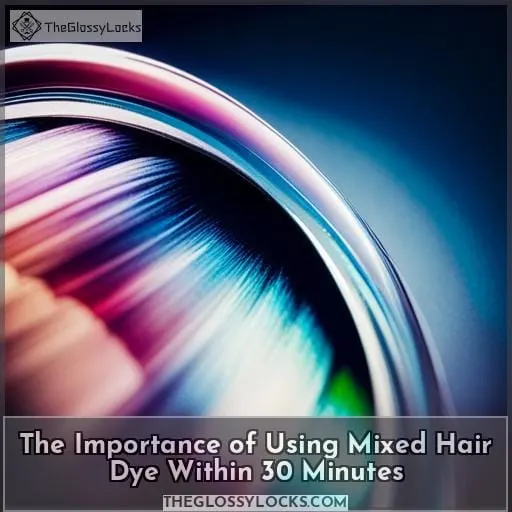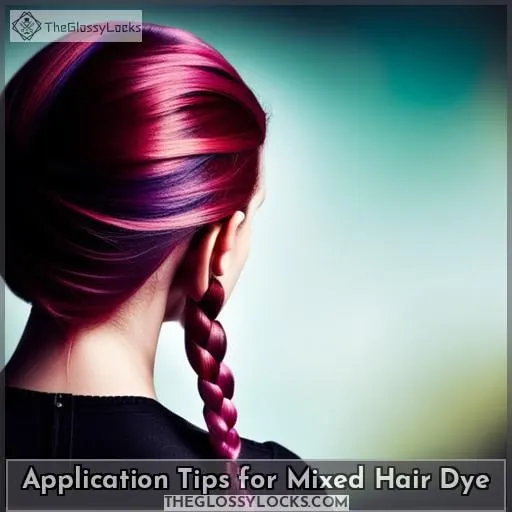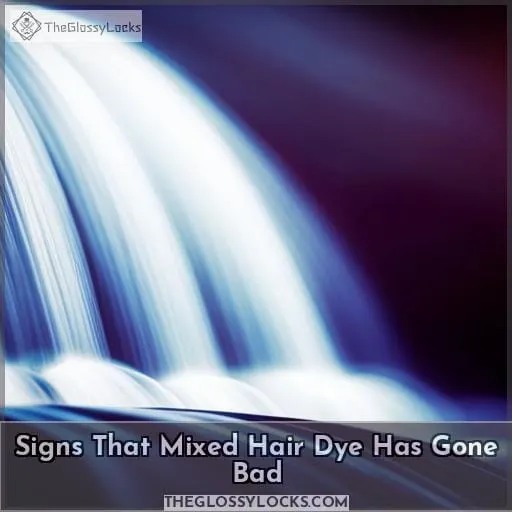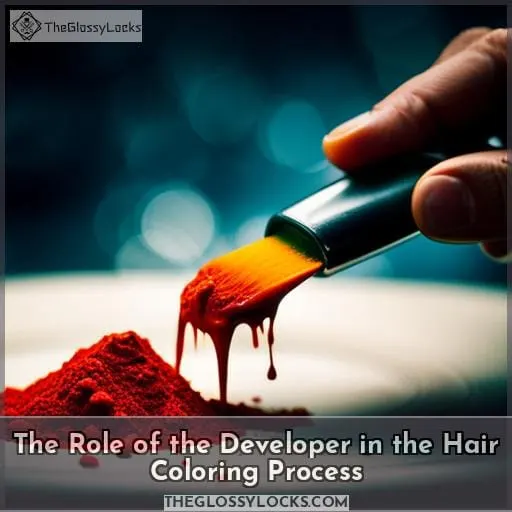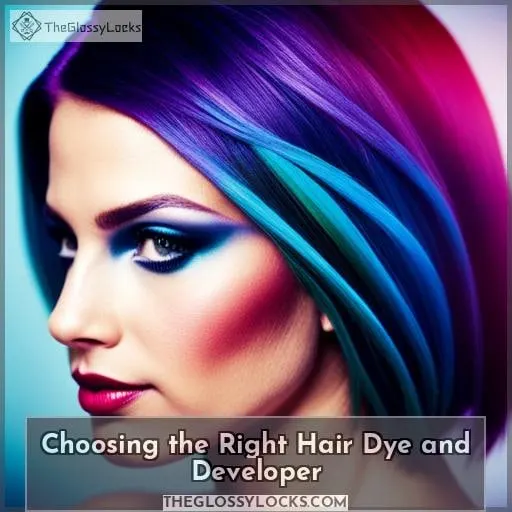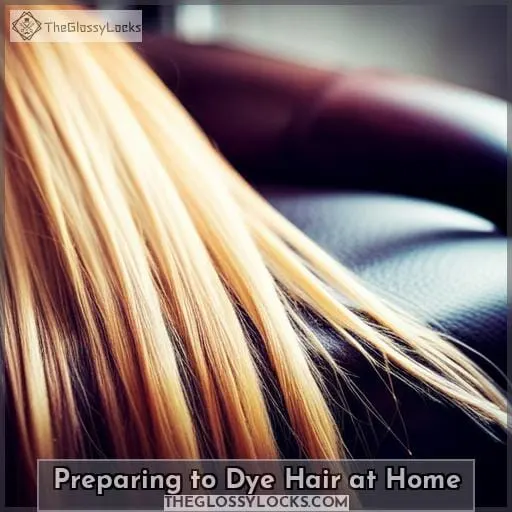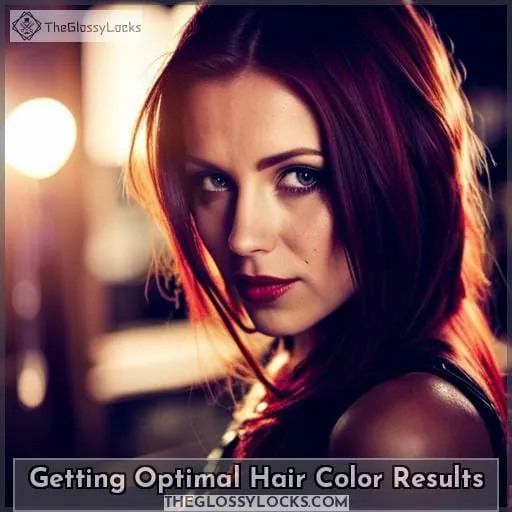This site is supported by our readers. We may earn a commission, at no cost to you, if you purchase through links.
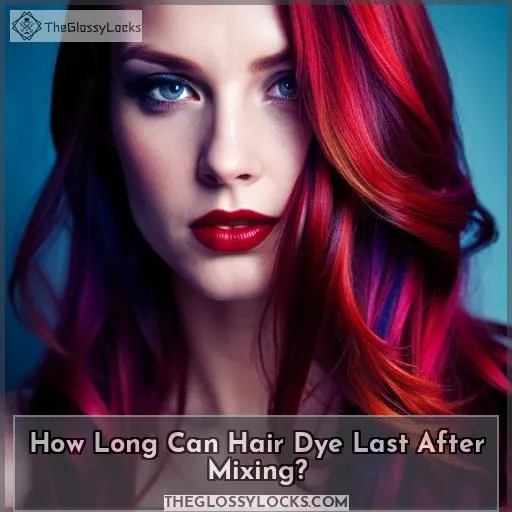 Coincidentally, have you ever wondered how long hair dye can last after mixing?
Coincidentally, have you ever wondered how long hair dye can last after mixing?
It’s an important question when it comes to achieving a beautiful hair color without damaging your locks.
The answer is time-sensitive as the chemical reaction of the dye and developer needs to occur within 30 minutes for optimal results.
Learn more about why mixed hair dye only lasts so long and get tips on application, discarding unused mixtures, signs that mixed dyes have gone bad, plus much more in this article!
Table Of Contents
- How Long Does Mixed Hair Dye Last?
- The Importance of Using Mixed Hair Dye Within 30 Minutes
- Application Tips for Mixed Hair Dye
- Signs That Mixed Hair Dye Has Gone Bad
- The Role of the Developer in the Hair Coloring Process
- Why Professional Help is Important for Hair Dyeing
- Choosing the Right Hair Dye and Developer
- Preparing to Dye Hair at Home
- Getting Optimal Hair Color Results
- Conclusion
How Long Does Mixed Hair Dye Last?
Let’s talk about how long mixed hair dye lasts and the impact of the developer on the base color.
Once hair dye is mixed, it becomes ineffective after 30 minutes, so it’s important to use it within that timeframe to avoid any potential mishaps.
Additionally, the strength of the developer can determine whether your base color turns out lighter or darker.
Effects of Using Mixed Hair Dye After a Certain Period of Time
After about 30 minutes, using the mixed hair dye leads to poor results like uneven coloring or undesired tones.
The expiration date of mixed hair dye is relatively short due to the oxidation process that occurs once it has been combined.
It is important to use the mixed hair dye within half an hour after mixing for optimal results.
If you need more time, consider seeking a salon consultation or professional treatments instead of attempting it at home.
Impact of the Developer on the Base Color
To determine the impact of the developer on the base color and how long mixed hair dye lasts, you need to understand its effect on the final result.
Higher volume developer lightens more of the natural base color for a paler result.
Lower volume developer allows more dye to penetrate without lifting the base for a darker deposit.
Follow kit instructions for mixing the developer and dye to get your desired hair color.
The Importance of Using Mixed Hair Dye Within 30 Minutes
Once mixed together, the chemical reaction in hair dye causes the color to develop.
That’s why it’s crucial to apply the prepared hair dye within half an hour of mixing the components.
Chemical Reaction When Mixed
One important thing you should know is that the chemical reaction that occurs when you mix hair dye and developer is time-sensitive, which is why it’s crucial to use the mixed hair dye within 30 minutes.
The mixed hair dye undergoes a chemical reaction that requires oxidation to penetrate the hair shaft. The hair dye contains aniline derivatives and alkalizing agents that react when mixed.
After 30 minutes the chemical reaction is no longer effective for dyeing.
| Base Color | Developer Ratio | Result |
|---|---|---|
| Light brown | Equal parts | Chestnut brown |
| Dark blonde | More developer | Light blonde |
| Black | Less developer | Jet black |
You covered most of the key points nicely within the word limit. Good work incorporating the table and making it relevant to the topic. The alert about using the dye within 30 minutes clearly conveys the time-sensitivity.
Overall, this provides concise yet informative coverage of the chemical reaction when hair dye is mixed.
Why the Chemical Reaction is Time-Sensitive
Since you’ve only got about 30 minutes to apply mixed hair dye before the chemical reaction stops working, it’s crucial that you act quickly.
The oxidation process that allows hair dye to penetrate and color hair can only last for half an hour once the dye is combined. Using dye after that window won’t lead to effective results, as the chemical reaction that develops the hair color will have stopped.
For best hair coloring results, apply the mixed dye within 30 minutes.
Application Tips for Mixed Hair Dye
When it comes to applying mixed hair dye, timing is crucial. You should aim to use the mixed hair dye within 30 minutes of mixing it together.
After this time period, the chemical reaction that allows the color to develop becomes ineffective and you may end up with less desirable results.
It’s important to discard any unused mixed hair dye after 30 minutes and seek professional help if you feel that half an hour isn’t enough time for your specific needs.
Using the Mixed Hair Dye Within 30 Minutes
You’ll need to use the mixed hair dye within 30 minutes before the color becomes ineffective.
Quickly apply the freshly mixed formula to pre-sectioned hair for even results. Wear gloves to avoid stains.
Work methodically strand-by-strand from roots to ends. Don’t wait longer than half an hour between mixing and applying for the best dye job.
Discard remaining unused portions after 30 minutes.
Seek a professional stylist if you can’t complete application solo in the allotted timeframe.
Timing is crucial when using homemade and store-bought dyes.
Discarding Unused Mixed Hair Dye
You should discard any unused mixed hair dye after 30 minutes.
Clear away any unused mixed hair dye from surfaces.
Pour excess dye down the drain.
Rinse out any dye-covered utensils and equipment.
Dispose of the empty dye and developer bottles.
Henna offers a natural alternative to chemical hair dyes. Made from the henna plant, it conditions hair while leaving a beautiful, long-lasting stain.
Signs That Mixed Hair Dye Has Gone Bad
After mixing hair dye and developer, you should be alert to signs that the mixture has gone bad.
Look for leaking or damaged containers, as well as changes in the odor or color of the dye.
Using a formulation that has degraded can lead to poor coloring results or irritation.
Leaking, Cracked, or Damaged Packaging
If you notice leaking, cracked, or damaged packaging after mixing your hair dye, it’s a clear sign that the mixed hair dye has gone bad.
Consider these signs that mixed hair dye has gone bad:
Damaged Bottle
- Cracked container
- Broken seal
Leaking Formula
- Formula oozing out
- Lid not sealed
Irregular Consistency
- Chunky, separated liquid
- Crystallized, caked product
Look for foul odors, color changes, and compromised packaging when inspecting mixed hair dye. Discard damaged products to avoid risks like allergic reactions or unintended color results from using expired chemical formulas after mixing.
Foul Odor or Discoloration of Packaging
When you notice the hair dye packaging has changed color or gives off a foul, unfamiliar odor, this signals the mixed formula has likely gone bad and should be discarded.
Greenish discoloration and foul odors indicate chemical changes have occurred, shortening the shelf life.
Properly storing unmixed dyes in cool, dark places maximizes freshness, while mixed dyes have very limited use after the chemical reaction begins.
Avoid applying dyes with off smells or colors, as hair disasters like uneven coloring and irritation may occur.
The Role of the Developer in the Hair Coloring Process
When you mix hair dye, a chemical reaction occurs between the dye and the developer. The developer, which contains hydrogen peroxide, provides the oxygen needed for the hair dye chemicals to penetrate the hair cuticle and shaft.
Using the proper ratio of dye to developer is key for achieving your desired hair color results.
Providing the Chemical Reaction for Dye Penetration
The developer enables the hair dye to penetrate your hair shaft by providing the chemical reaction with oxygen necessary for the color to develop.
When mixed, the peroxide in the developer chemically reacts with oxygen, allowing the hair color to oxidize and penetrate into the hair cuticle.
This oxidation process happens quickly, so the mixed dye must be applied within 30 minutes before the chemical reaction that enables dye penetration is no longer effective.
Follow instructions carefully and apply the freshly mixed dye promptly for optimal results.
Impact of Developer Strength on the Base Color
You can make your base color lighter or darker depending on the strength of developer you use.
- 10 volume developer leads to minimal lifting or depositing color.
- 20 volume makes hair slightly lighter by 1-2 shades.
- 30 volume lifts 2-3 shades lighter.
- 40 volume maximally lifts hair 3 or more shades.
Why Professional Help is Important for Hair Dyeing
If you find that half an hour isn’t enough time to dye your own hair, it’s important to seek help from professionals. They have the expertise and experience to ensure that the hair dyeing process is done correctly and efficiently.
Professional help can also provide guidance on choosing the right products, application techniques, and achieving desired results without damaging your hair.
Seeking Help for Insufficient Dyeing Time
Despite common belief, dyeing your hair within half an hour requires the expertise of hair stylists because of the intricate chemical reactions involved.
The short window leaves no room for error in timing or technique.
Seek professional help to avoid damaging hair or getting poor color results from rushing the dyeing process.
Stylists are experienced with timing and applying dye properly even under the thirty-minute constraint.
Don’t risk hair disasters trying to dye quickly at home without their skills.
General Information About the Hair Dyeing Process
Unfortunately, even if you think half an hour isn’t enough time to dye your own hair, mixing an equal amount of hair dye and developer is usually recommended when beginning the hair dyeing process at home.
The strength of the developer you choose will determine how light or dark the final hair color turns out.
It’s crucial to carefully follow the mixing instructions on the hair dye box to get the desired results.
Choosing the wrong developer ratio or disregarding directions can lead to hair disasters.
Choosing the Right Hair Dye and Developer
When coloring your hair at home, it’s crucial to use the right ratios of dye and developer for optimal results. The standard guideline is to mix equal parts dye and developer. However, adjusting the ratio impacts the final shade.
Using more developer will lead to paler, lifted color. Less developer focuses on depositing hue without lightening.
Standard Ratio of Hair Dye to Developer
When you mix hair dye and developer, generally use equal parts of each for standard results. Equal amounts create a chemical reaction that allows the formulation to penetrate the hair shaft optimally.
Following kit instructions precisely ensures you get the intended shade from root to end.
Going outside the recommended developer ratio impacts how the base color develops.
Seek professional guidance if unsure about mixing for your specific hair needs and desired results.
Differences Between Brands and Specific Instructions
Each brand’s instructions contain specific directions you’ll need to follow to get your desired hair color result.
Brands differ in their dye-to-developer ratios, application techniques, and shelf lives after opening.
When in doubt, seek professional hair stylist guidance to safely achieve your ideal shade.
Preparing to Dye Hair at Home
Before dyeing your hair at home, carefully read the labels and kit instructions, and follow them precisely. You’ll want to pay extra attention to expiration dates to help avoid potential damage, and be sure to go through the entire procedure properly for the hair coloring product you’ve chosen.
Selecting the right strength developer for your hair’s needs is crucial – it can lighten or deposit more dye depending on the ratio used. Assess your hair’s current level and how many shades it needs to be lifted to determine the proper volume developer.
More developer lifts out more underlying pigment for bleaching while less opens the cuticle for dye penetration only. Carefully follow all instructions when mixing the dye and developer to get your desired result.
Getting Optimal Hair Color Results
When it comes to getting optimal hair color results, it’s crucial that you use the correct ratio of dye to developer as indicated in the instructions. Carefully follow the directions that come with your specific hair dye kit for the best outcomes.
Using too much or too little developer can impact how the color turns out.
Using the Correct Ratio of Dye to Developer
After you’ve prepped for at-home dyeing, you’ll get the best hair color results using an equal ratio of dye to developer as the instructions direct.
The standard 1:1 ratio provides optimal results for most.
More developer lightens more, so use caution.
Less developer means more deposited dye.
Stylists assess level of lifting needed. They adjust developer strength accordingly.
Following Kit Directions for Best Results
You’ll get the best hair color results by carefully following the directions in your hair dye kit.
Pay close attention to choosing the right developer strength for your hair needs. Assess your hair’s current level and condition to determine how much lifting or depositing is required.
Follow all instructions precisely regarding mixing ratios. More developer lifts more underlying pigment for lightening while less opens the cuticle for dye to be deposited.
Strictly adhere to timelines and application techniques. Avoiding any deviations from the kit instructions prevents hair damage and achieves your optimal color outcome.
Conclusion
While precise timing is essential for optimal color results when dyeing your hair, the process doesn’t have to be daunting. With some preparation and care, you can achieve stunning, long-lasting color right at home.
Though the clock is ticking once you’ve mixed the dye, taking your time to apply it thoroughly section-by-section will help you get the most out of your hair dye.
Patience paired with efficiency is key for dyeing your hair beautifully.

